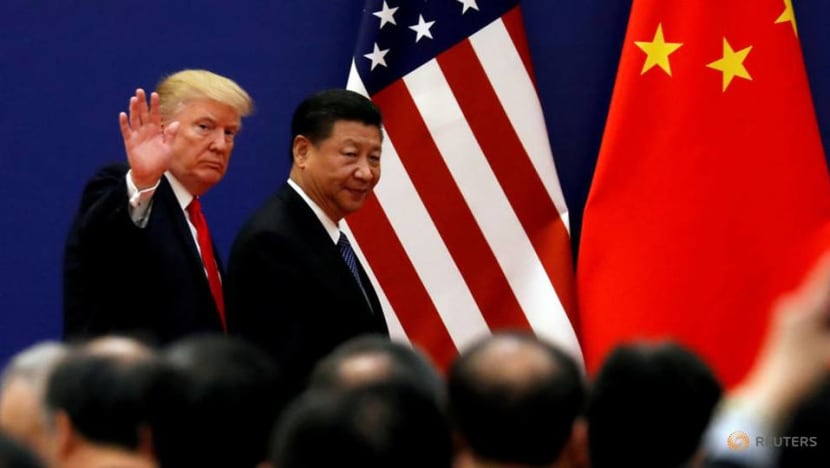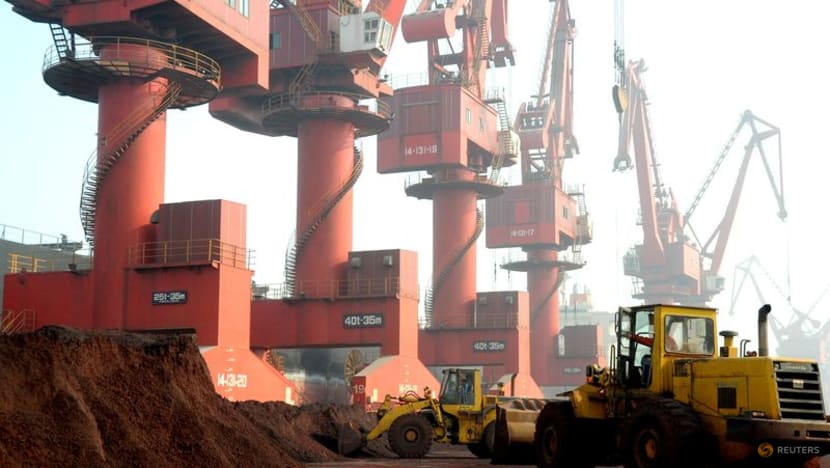Commentary: US and China slash tariffs but a grand trade bargain is still impossible
No concession will resolve what Beijing and Washington view as an existential struggle between competing systems, says Enodo Economics’ Diana Choyleva.

US President Donald Trump and China's President Xi Jinping meet business leaders at the Great Hall of the People in Beijing, China, Nov 9, 2017. (File Photo: Reuters/Damir Sagolj)
LONDON: The speed with which the tariffs unwound suggests the trade war was causing severe pain on both sides. China's export machine remains a crucial economic pillar, while rising prices for everyday Americans have led President Donald Trump to lash out at Corporate America to "eat the tariffs".
Still, the dramatic reduction in tariffs announced on May 12 exceeded even my expectations. Chinese President Xi Jinping's strategy of defiance appears to have paid dividends: His team achieved substantially lower tariffs, while making only concessions China was willing to make in the first place.
Talks between Treasury Secretary Scott Bessent and Vice Premier He Lifeng produced a 90-day tariff pause, with the suspension of most China-specific punitive tariffs. This puts it on somewhat equal treatment with other US trading partners.
Chinese goods now subject to a 30 per cent additional US tariff (down from 145 per cent) and American goods facing a 10 per cent Chinese tariff hike (down from 125 per cent).
COORDINATED DIPLOMATIC COMMUNICATION – FOR A CHANGE
China's delegation presented a formidable negotiating front, led by Mr He, an experienced economic policymaker with close ties to Mr Xi. Joining him were Vice Commerce Minister Li Chenggang, who formerly served as China's World Trade Organization envoy, and Vice Finance Minister Liao Min, who participated in the Trump 1.0 trade negotiations.
This well-coordinated Chinese team was in contrast with Washington's more ad hoc assembly. Mr Bessent brought Wall Street credibility, but his team is still finding its footing in the complex dance of US-China trade diplomacy to Mr Trump’s unpredictable beat.
In the wake of the talks, both sides have introduced further concessions aimed at smoothing the path towards continued dialogue. China has reportedly allowed shipments of Boeing to resume, after saying last month it refused to accept delivery of new aircraft. The US has further slashed its de minimis tariff on Chinese parcels small-value parcels.
The coordinated announcement was notable for the absence of Mr Trump's usual social media front-running, further reflecting China's preference for carefully managed diplomatic communication.
The most significant outcome from the Switzerland talks is the establishment of "a mechanism to continue important discussions about trade and economics". This provides a formal framework for dialogue that could help prevent future miscalculations or rapid escalations.
PRIORITIES OF FENTANYL, RARE EARTHS
China's primary concession – addressing fentanyl trafficking – was delivered with diplomatic finesse. In an unprecedented move, Beijing dispatched a vice minister from the Ministry of Public Security to the trade talks, marking the first time such a senior security official has participated in economic negotiations. It signalled serious intent on tackling the issue with minimal economic sacrifice.
Mr Bessent acknowledged the significance, noting the two sides "had a very robust and productive discussion on steps forward on fentanyl", with the joint statement pledging "aggressive action" to stem the flow of the opioid and precursor chemicals from China – potentially unlocking the removal of an additional 20 per cent fentanyl-related US tariff in future talks.
Beijing has also reportedly agreed to roll back "non-tariff" measures imposed since earlier this year, which might include export controls on rare earths – a priority concern for the White House.
However, on May 14, China granted export permits to four domestic rare earth magnet producers, which doesn't indicate a rollback of its April export controls as markets initially hoped. The controls were not implemented specifically against America but as a mechanism for potential future leverage.
The permits do demonstrate that Beijing's licensing system is now operational, suggesting some US applications may receive approval during negotiations to honour the ceasefire spirit.
The export controls remain firmly in place, allowing China to maintain compliance with the trade truce while preserving strategic leverage over critical materials. This nuanced approach reflects Beijing's sophisticated long-term strategy rather than a concession in the current trade detente.

THREE-MONTH PAUSE WITH LITTLE CHANCE FOR BARGAIN
Beyond tariff rates, trade deficits and export controls, there was always a deeper ideological divide. While immediate trade war risks have diminished, the fundamental schism between the US and China makes any grand bargain impossible.
Xi Jinping's January statement in party journal Qiushi that "Western countries are increasingly in trouble" because "they cannot curb the greedy nature of capital" reveals a fundamentally adversarial worldview. This dark vision of the West, with America at its heart, frames China’s Communist Party as the final barrier protecting China from Western capitalist exploitation.
Meanwhile, the Trump administration's upcoming America First Investment Policy, planned expansion of the Entity List and more selective tariff strategies all point toward accelerated economic decoupling despite the temporary thaw, and despite Mr Bessent's assurance to CNBC that "the US doesn't want a generalised decoupling but wants to protect strategic necessities."
A durable resolution remains challenging given the complex bilateral relationship and deep-seated mutual suspicion.
China now has a three-month window to negotiate a broader arrangement. But one thing is evident: There can be no compromise on what it considers key parts of its economic and political system, like its industrial policy and self-sufficiency drive.
The suspension window will likely lead to more frontloading of Chinese shipments to the US in May and June, potentially boosting growth prospects and helping Beijing achieve its 5 per cent annual target.
For the US, the path forward will mean deploying targeted tariffs in industries vulnerable to Chinese imports or where Washington hopes to support reshoring of supply chains. For China, this necessitates accelerating the transition to consumption-led growth that reduces reliance on American markets.
THE FUNDAMENTAL REALITY
Mr Trump has dangled the prospect of a call with Mr Xi and the temporary thaw certainly sets the stage for the two leaders to finally speak – or even meet. But this detente will last only as long as Washington prioritises domestic economic confidence.
The reality remains unchanged: Washington is long past the point where Beijing will consider its actions as in good faith. No temporary concession or policy adjustment will resolve what both sides increasingly view as an existential struggle between competing systems.
While markets can breathe easier for now, investors should recognise this as a tactical pause in a strategic competition that will define the global economy for years to come.
Diana Choyleva is the founder and chief economist of Enodo Economics and a senior fellow at the Asia Society Policy Institute’s Center for China Analysis.



















